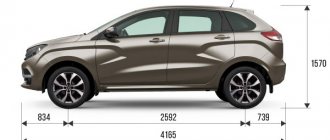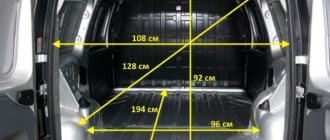Linear dimensions of the cargo compartment of the Lada Largus van
All the sizes you need to know are shown in the photo. The van doors here are fixed at an angle of 90 degrees, but they can be opened all the way to 180. They are fixed in either of the two positions.
Luggage compartment of a Largus van
Let's list everything that is marked in the figure:
- The greatest height of the opening is 92 cm;
- Opening width – 108 cm;
- The distance “from arch to arch” is 96 cm;
- The distance from the edge of the threshold to the partition is 194 cm.
If you lay sheets diagonally, the width of the sheet should be less than 130 cm.
When the partition remains in place, the internal volume of the Lada Largus van is 2540 liters. Load capacity is 725 kg. These figures are indicated by AvtoVAZ.
In fact, the maximum lifting capacity exceeds a ton. It all depends on the road conditions and driving style.
Unfasten the partition or part of it
The partition separating the body and the cabin consists of two halves. They can be removed separately. Both parts are screwed to the body with screws designed for a 13mm key size. Of course, you need a socket wrench.
Screws 1 were hidden under the casing
The four screws on the left and right are located on the cab side. And to unscrew them, remove the casing.
All actions with cladding
The left part of the septum is removed after the right. To remove only the left half, first remove both, and then mount the right sash back. Based on this, immediately decide where you will remove the trim - only on the right or on both sides.
The volume of the body on the Lada Largus van cannot be greatly increased, even if the partition is completely removed. But without the partition, by removing the seat, it will be possible to transport loads 3 meters long.
So, let's start dismantling the trim: you need to remove the seat belt (key “17”), and then unscrew one self-tapping screw. A Torx T20 wrench is suitable for the self-tapping screw.
Options and prices
For the Russian market, Lada Largus 2022 is offered in 3 trim levels: Standard, Norma and Luxe. The “Standard” assembly costs 524.5 thousand rubles and has an eight-valve K7M power unit with a 5-speed manual JH3 gearbox, as well as:
- Driver's airbag;
- Seat belts for the driver and passenger sitting next to them with a limiter function;
- Clips for child seats;
- Vacuum booster of the brake system;
- Mechanical optical lighting corrector;
- Inertial seat belts (5 pieces);
- Head restraints on the rear seats;
- Locking doors from opening by children;
- Immobilizer;
- Fabric seat upholstery;
- Plastic upholstery;
- Brushed carpets in the cabin and trunk;
- Bracket for securing cargo;
- Adjustable steering wheel tilt;
- Lighting in the trunk;
- Alarm indicating that the side lights are not turned off;
- Single ignition and door key;
- Audio preparation;
- Stamped 15-inch “rollers”;
- Electronic systems ABS and EBD;
- 12-Volt socket;
- Cabin air filter;
- Light tinting;
- Railings
- Full size spare wheel.
Next comes the performance “Norma”, which is estimated from 544,000 rubles. It has:
- Sun visor with mirror for the front passenger;
- Possibility of folding the passenger seat in a ratio of 60:40;
- Hydraulic power steering;
- Seat belt height adjustment;
- Central castle;
- Electric windows on the front windows;
- Bumper painted in the same tone as the body;
- Moldings on the side doors.
The “Norma” version has additional packages of “Climate” and “Control” options. The price will be higher – 566,000 and 601,500 rubles, respectively. In “Climate” you can see the presence of air conditioning and heated front seats. The Comfort has already installed an airbag for the front passenger with a function to turn it off, a luggage rack, a curtain shelf in the trunk, as well as an audio system with a pair of speakers.
The “Lux” version has already received:
- Sound signal in 2 tones;
- On-board computer;
- Fabric inserts on door trim;
- Chrome elements in the interior trim;
- Leather trim of the “steering wheel”;
- Ability to adjust the driver's seat with lumbar support in height;
- Cigarette lighter with ashtray;
- Pockets on front seats;
- Central locking with remote control;
- Power windows on rear windows;
- Exterior mirrors with electric drive and electric heating function;
- Painting door handles and mirror trims to match the body paint;
- Thresholds on the front doors;
- Fog lights;
- 15-inch cast “rollers”;
- Audio system with four speakers;
- Front and rear parking sensors;
- Parktronic.
For this option you will have to pay at least 633,700 rubles. There is also a model that received stamped rather than cast wheels. For this you will need to pay an additional 10,000 rubles.
Increasing the volume of the cargo compartment (removing the excess part on the floor)
The cargo compartment volume of the Lada Largus van can be increased. To do this, remove the floor covering.
There are two types of fasteners here
We will need special Torx keys, without which the screws cannot be unscrewed: Torx T30 and T40.
Study the picture carefully:
- T40 caps (2) are located at the corners, as well as on the line between the arches;
- The remaining screws (1) are designed for Torx T30 keys.
Removing the trim will be easy. And when you install it, make rubber gaskets. They are fixed to the ends of the frame so that the casing does not rust.
The removable floor (cladding) consists of two halves - left and right. First, according to tradition, the right one is removed.
Lada Largus technical specifications
Many potential car buyers are interested in the main technical characteristics of the Lada Largus. The car is a clone of the Dacia Logan MCV car of the Renault-Nissan alliance, which has gained some popularity in Europe, redesigned for domestic operating conditions. The Lada Largus model has similar technical characteristics. The car body type belongs to the category of high-capacity station wagons, and the dimensions of the Lada Largus allow the car to be classified both as spacious family cars and ultra-compact commercial vans.
Return to contents
Main body dimensions
The dimensions of the Lada Largus car differ little from those of its competitors, such as Fiat Doblo, Renault Kangoo, Peugeot Partner, Citroen Berlingo, Skoda Roomster, Volkswagen Caddy, Ford Connect Transit. The overall dimensions (body length/width/height) of the Peugeot Partner are 4380/1810/1800 mm, and the body dimensions of the Lada Largus are approximately the same.
Main dimensions of Lada Largus:
- length - 4470 mm;
- width - 1750 mm;
- height (including the dimensions of the roof rails) - 1670 mm;
- car base - 2900 mm;
- front track - 1469 mm;
- rear track - 1466 mm;
- front overhang - 795 mm;
- rear overhang - 770 mm;
- ground clearance under the lowest point of the engine - 145 mm;
- turning radius - 5.62 m.
The Lada Largus body has a hinged rear door. This ensures easy access to the luggage compartment, even in limited parking spaces. The left rear door leaf is noticeably wider than the right one, and the design of the car allows only it to be opened when loading and unloading.
Consumers care whether the Largus body is galvanized. It is known that all steel panels of the machine are double-sided galvanized.
Return to contents
Station wagon engine
The car comes with an 8-valve or 16-valve 4-cylinder fuel-injected engine with multiport fuel injection. The volume of these engines is 1598 cm3; cylinder diameter - 79.5 mm; piston stroke - 80.5 mm; compression ratio - 9.8. The 8-valve engine produces 90 horsepower and a torque of 128 N∙m. The maximum speed of Largus, equipped with such an engine, is 158 km/h, and acceleration to 100 km occurs in 13.4 s. The 16-valve engine is slightly more powerful, it produces 105 horsepower and a maximum torque of 148 N∙m. In this version, the maximum speed is 165 km/h, acceleration to 100 km is 11.8 s.
Lada Largus engines consume gasoline with an octane rating of 95. The car complies with Euro 4 standards. Lada Largus fuel consumption per 100 km in the combined cycle for a 5-seater version and a 16-valve engine is 11.5 liters, and on the highway - 7.6 liters per 100 km.
Crash test Lada Largus
The station wagon can hardly be called a new car. For those who have already bought this car, its pros and cons are known. However, those who are just thinking about buying this model may be confused. Perhaps crash tests of Lada Largus will help get a more objective picture.
Like all vehicles, the Lada Largus station wagon underwent mandatory crash tests. During a side test, a special trolley crashed into the car at a speed of 50 kilometers per hour. The car performed quite well in such a test. Due to the damage, the car doors could not open.
The dummy, which was inside the car at the time of the study, received damage to the head 8 times lower than allowed. If we talk about pelvic injuries, then here too Largus copes with the assigned tasks, meeting these standards threefold. If we talk about damage to the car after being hit from behind, then Largus did not disappoint here either, since it provides excellent protection against unnecessary injuries.
During the impact with the movable barrier at a speed of 36 kilometers per hour, the interior remained intact and the seats were secured. It is also interesting that the side windows, along with the glass of the rear trunk door, were not damaged. The fuel tank is perfectly protected by the spare tire and suspension parts. That is why during a crash test it remains unharmed.
Tests of the Lada Largus station wagon have shown that the car meets all legal safety requirements. Crash tests were carried out under more difficult conditions. The established rules for a frontal collision indicate an impact at a speed of 56 kilometers per hour, and the VAZ was tested at a speed limit of 64 km/h, which is 8 kilometers per hour more than the norm.
After the tests, the car received 8.32 points out of 10 possible, which is an excellent result, comparable to the Logan MCV, which received 8 points in 2005. It turns out that you can and even need to buy a Lada Largus station wagon.
Control dimensions of Lada Largus body geometry / Lada Largus
Dimensions of openings and clearances of mating parts of the LARGUS body
| A | B | IN | G | D | E | AND | 3 |
| 1380 ± 5 | 930 ± 4 | 1280 ± 5 | 1155 ± 15 | 925 ± 5 | 975 ± 5 | 1110 ± 5 | 610 ± 3 |
| AND | TO | L | M | N | ABOUT | P | |
| 795 ± 3 | 735 ± 3 | 1530 ± 5 | 800 ± 5 | 1380 ± 4 | 1030 ± 3 | 1140 ± 3 |
Mounting points for suspensions on the body
1 — front subframe mounting points; 2 — mounting points for the shock absorber strut; 3—rear subframe mounting points; 4 — guide holes of the front spar; 5 — front guides of the rear spar; 6 — guide holes for mounting the rear suspension; 7 — rear suspension mounting holes; 8 - holes for mounting the rear shock absorber; 9 — rear guide holes of the rear spar.
Scheme for measuring interaxial dimensions
dimensions and dimensions in centimeters, length, width
LADA Largus has long won the sympathy of Russian car enthusiasts. Drivers often pay attention to the large trunk volume of the Lada Largus, which is considered the main advantage of this car. Domestic cars also cope well with another task - providing inexpensive and comfortable travel on modern roads. These two aspects and the ability to accommodate a large number of passengers allowed the car, produced at the Russian AvtoVAZ, to become a popular model in the CIS countries.
The dimensions of the Largus trunk depend on the body variation, it can be:
Salon
The interior of the 2022 Largus is almost no different from the same Logan. The salon is ascetic and unremarkable. When viewing the dashboard and other elements, you can see existing ergonomic mistakes that were still characteristic of Logan. “Tidying” turned out to be laconic. There is a two-color on-board computer display and an instrument dial with a chrome trim.
The entire dashboard is informative and does not distract the driver from driving. The steering wheel turned out to be large and fixed on 3 spokes, and also has height adjustment. In the center there is a Lada nameplate. The number of controls on the center panel is limited. The maximum configuration has a radio that supports AUX and USB connectors .
The entry-level and mid-range versions received a simple plastic plug instead of the radio. Near the plug there are controls for the ventilation system and heating (there is an air conditioner and a stove). Between them are the keys for the electric drive of the windows installed on the front windows. There is also a rear door lock, heated rear window and hazard warning lights. The center console itself has a metal trim.
This car became the first joint project of AvtoVAZ and the French-Japanese alliance Renault-Nissan.
As for the interior upholstery of the Lada Largus, hard plastic and fabric were used in its manufacture. Seating provides only a minimum level of comfort. The seats installed in front turned out to be flat, there is lateral support, but it is minimal. But the arsenal of settings for the front seats turned out to be large.
The luxury version boasts driver lumbar support and seat height adjustment. The round air ducts of the ventilation system are edged with metallized rings. Passengers in the second and third rows will not feel discomfort due to the lack of free space. Three adult passengers will be pleased with the air ducts provided for them.
The roof does not cause depressing thoughts, but it is worth noting that getting into the 3rd row of seats is not very convenient. However, it is important not to forget that the car was created to transport goods and passengers on a budget basis. A car shouldn’t be too comfortable, but it performs its main tasks well.
Despite the cheap interior and upholstery, everything is made quite well and robustly. If there are any extra noises or squeaks from poorly fixed parts, they are not very disturbing, as in other cars of this niche.
The trunk volume of the five-seater Largus model is 560 liters. This is the best result among station wagon B-class cars officially available in Russia (as of 2014).
I would also like to say something about the trunk of the Lada Largus 7. The modification of the car with 5 passenger seats has a volume of usable space of 560 liters. If you fold the rear seats, the volume increases to 2,350 liters. It turns out that you can transport furniture, refrigerators and other large items without much difficulty.
The passenger version with seven seats has 198 liters of volume, as well as the ability to easily remove the rearmost row. This allows you to use the car as a cargo truck and have the same spacious luggage compartment. A full-size spare wheel is located under the bottom, and the tailgate can be opened in two asymmetrical parts by 180 degrees.
The Lada Largus Furgon modification has a volume of 2,500 liters and can carry 800 kilograms of cargo. The data is very impressive. There is nothing better for summer residents, gardeners and small businesses.
Technical characteristics of Largus van. Lada Largus van body length
Dimensions of the Lada Largus 2018 van
Dimensions of the Lada Largus van
Russian sales of Lada Largus began in July 2012. The car is available in 7- and 5-seater versions, as well as in a van body.
The car has the following technical characteristics: 8 and 16 valve petrol engine with a volume of 1.6 liters and a power of 87 hp. and 106 hp
The Lada Largus 2022 van has dimensions: 4470 mm in length, 1750 mm in width and 1650 mm in height. The volume of the luggage compartment is 2540 liters.
New video review and test drive of the van:
The station wagon consumes only about 8.1 liters per 100 km in the combined cycle
Tire sizes are 185/70R14, 185/65R15.
See vehicle specifications and prices here.
Technical characteristics of Largus van / MirAvto Lada
Technical characteristics of the Lada Largus station wagon in numbers. For ease of loading, the rear door leaves are fixed in 3 positions 40, 90 and 180 degrees. To properly secure the load, there are 6 mounting points, allowing you to secure even small items. The Lada Largus is equipped with the well-known Renault 1.6 16 valve engines with a power of 102 hp. and 8 valve with a power of 87 hp, only 5 manual transmissions are available. The van's load capacity is 800 kg and the trunk volume is 2540 liters. In the crash test, Largus scored 3 stars out of 5.
Appearance
If you turn your attention to the appearance of the Lada Largus station wagon, you can easily recognize in it an exact resemblance to the Dacia/Renault Logan MCV of the 1st family, except for small elements. Most similarities with the Tolyatti brand can be seen on the front of the vehicle. And it doesn’t matter who is in front of us - the passenger version or the Largus van.
The chrome horizontal line that crosses the grille rests on the . On top of that, the front part has modest optics and a bumper with soft patterns and an air intake “mouth”. The front headlights look quite modest. The luxury version allows you to install fog lights in the black recesses.
Lada Largus is the most spacious Russian passenger car. The name of the car was also not invented in vain - translated from Latin it means “generous”.
If you look at the car from the side, it looks like the most ordinary station wagon from another manufacturer. There is a sloping hood, a flat roof and large side glazing. The side repeats the design up to the edge of the doors of the 2nd row of the Renault Logan sedan. The wheelbase turned out to be stretched.
Lada Largus belongs to the station wagon division and over the entire period since the start of sales and use, the car has received a considerable number of good reviews. The ride height is 175 millimeters, which should be enough for everyday use. However, you need to be careful when traveling over rough terrain, especially if the car is loaded. The remaining sizes of Largus allow the station wagon to be used in many areas of life.
The rear of the Lada Largus 2022 received a huge cube-shaped stern. The stern looks quite normal. There are two asymmetrical hinged doors that go deep into the bumper and lighting columns, made neatly. The specialists did not forget to equip the car with a low loading height, which makes loading/unloading luggage much easier.
A rear wiper and heated glass function are provided. The appearance of the Lada Largus has hardly changed, if you do not take into account the new off-road versions. Interestingly, the 2nd Logan MCV family has already been presented to Romanian car enthusiasts. It is worth recognizing that the appearance of a new product in the near future in Russia is unlikely.
Perhaps they will decide to update the car a little and not earlier than the end of 2018. Based on the words of the manufacturer, the car will have some attributes of the new corporate style from Lada Vesta and XRay.











